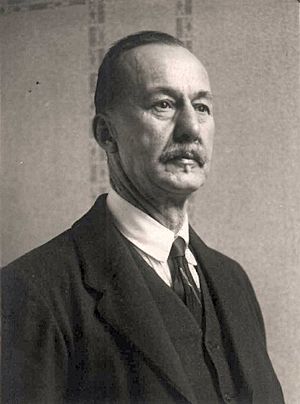Wilhelm Wirtinger facts for kids
Quick facts for kids
Wilhelm Wirtinger
|
|
|---|---|

Wilhelm Wirtinger
|
|
| Born | 19 July 1865 Ybbs an der Donau, Austrian Empire
|
| Died | 16 January 1945 (aged 79) Ybbs an der Donau, Greater German Reich
|
| Nationality | Austrian |
| Alma mater | University of Vienna |
| Known for | Complex analysis of one and several variables Wirtinger derivatives Wirtinger presentation Wirtinger's formula Wirtinger's inequality for functions Wirtinger's representation and projection theorem |
| Awards | Sylvester Medal (1907) |
| Scientific career | |
| Fields | Mathematics |
| Institutions | University of Innsbruck University of Vienna |
| Doctoral advisor | Emil Weyr Gustav Ritter von Escherich |
| Doctoral students | Wilhelm Blaschke Hilda Geiringer Kurt Gödel Wilhelm Gross Eduard Helly Leopold Vietoris Roland Weitzenböck |
Wilhelm Wirtinger (born July 19, 1865 – died January 16, 1945) was an Austrian mathematician. He worked on many different areas of mathematics, including complex analysis, geometry, algebra, and knot theory.
Contents
About Wilhelm Wirtinger
Wilhelm Wirtinger was born in a town called Ybbs on the Danube. He studied at the University of Vienna, where he earned his first degree in 1887. Later, he became a university lecturer in 1890.
Wirtinger was greatly inspired by another famous mathematician, Felix Klein. He studied with Klein at the University of Berlin and the University of Göttingen.
Awards and Recognition
In 1907, the Royal Society of London gave him the Sylvester Medal. This award was for his important work on the general theory of functions.
Wirtinger's Mathematical Work
Wilhelm Wirtinger was a very busy mathematician. He published 71 different papers during his career.
Key Research Areas
His first important paper, published in 1896, was about theta functions. These are special mathematical functions.
In 1897, he came up with an idea called the "spectrum of an operator." This idea helps mathematicians understand how certain mathematical "machines" (called operators) work. Another mathematician, David Hilbert, later expanded on this idea. Today, it's a very important part of a field called spectral theory.
Wirtinger also wrote papers on many other topics. These included complex analysis, geometry, algebra, and number theory. He even worked with Kurt Reidemeister on knot theory. In 1905, they showed how to figure out the "knot group," which helps describe different kinds of knots.
He also helped edit the "Analysis" section of a big math encyclopedia called Klein's encyclopedia.
Teaching and Students
Wilhelm Wirtinger was also a dedicated teacher. Many of his students went on to become important scientists themselves. Here are some of them:
- Alfred Berger
- Wilhelm Blaschke
- Hilda Geiringer
- Kurt Gödel
- Wilhelm Gross
- Eduard Helly
- Hans Hornich
- Erwin Schrödinger
- Karl Strubecker
- Olga Taussky-Todd
- Leopold Vietoris
- Roland Weitzenböck
See also
- Wirtinger inequality (2-forms)

